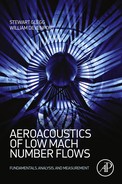Table of Contents
1.1 Aeroacoustics of low Mach number flows
1.2 Sound waves and turbulence
1.3 Quantifying sound levels and annoyance
1.4 Symbol and analysis conventions used in this book
2: The equations of fluid motion
2.2 The equation of continuity
2.6 Energy and acoustic intensity
2.7 Some relevant fluid dynamic concepts and methods
3.1 The acoustic wave equation
3.2 Plane waves and spherical waves
3.4 Sound generation by a small sphere
3.5 Sound scattering by a small sphere
3.6 Superposition and far field approximations
3.7 Monopole, dipole, and quadrupole sources
3.8 Acoustic intensity and sound power output
3.9 Solution to the wave equation using Green's functions
3.10 Frequency domain solutions and Fourier transforms
4: Lighthill's acoustic analogy
4.2 Limitations of the acoustic analogy
4.4 Monopole, dipole, and quadrupole sources
4.5 Tailored Green's functions
4.6 Integral formulas for tailored Green's functions
4.7 Wavenumber and Fourier transforms
5: The Ffowcs Williams and Hawkings equation
5.2 The Ffowcs Williams and Hawkings equation
5.5 Ffowcs Williams and Hawkings surfaces
5.6 Incompressible flow estimates of acoustic source terms
6: The linearized Euler equations
6.4 Acoustically compact thin airfoils and the Kutta condition
6.5 The Prantl–Glauert transformation
7.2 Sound from two line vortices in free space
7.3 Surface forces in incompressible flow
7.5 Blade vortex interactions in incompressible flow
7.6 The effect of angle of attack and blade thickness on unsteady loads
8: Turbulence and stochastic processes
8.2 Averaging and the expected value
8.3 Averaging of the governing equations and computational approaches
8.4 Descriptions of turbulence for aeroacoustic analysis
9.1 Homogeneous isotropic turbulence
9.2 Inhomogeneous turbulent flows
Part 2: Experimental approaches
10: Aeroacoustic testing and instrumentation
10.1 Aeroacoustic wind tunnels
10.2 Wind tunnel acoustic corrections
10.4 The measurement of turbulent pressure fluctuations
11: Measurement, signal processing, and uncertainty
11.1 Limitations of measured data
11.3 Averaging and convergence
11.4 Numerically estimating fourier transforms
11.5 Measurement as seen from the frequency domain
11.6 Calculating time spectra and correlations
11.7 Wavenumber spectra and spatial correlations
12.1 Basic delay and sum processing
12.2 General approach to array processing
12.4 Correlated sources and directionality
Part 3: Edge and boundary layer noise
13: The theory of edge scattering
13.1 The importance of edge scattering
13.2 The Schwartzschild problem and its solution based on the Weiner Hopf method
13.3 The effect of uniform flow
13.4 The leading edge scattering problem
14.1 The compressible flow blade response function
14.3 An airfoil in a turbulent stream
14.4 Blade vortex interactions in compressible flow
15: Trailing edge and roughness noise
15.1 The origin and scaling of trailing edge noise
15.2 Amiet's trailing edge noise theory
15.3 The method of Brooks, Pope, and Marcolini [8]
Part 4: Rotating blades and duct acoustics
16.2 Time domain prediction methods for tone noise
16.3 Frequency domain prediction methods for tone noise
16.4 Broadband noise from open rotors
16.5 Haystacking of broadband noise
16.6 Blade vortex interactions
17.2 The sound in a cylindrical duct
17.4 The Green's function for a source in a cylindrical duct
17.7 The radiation from duct inlets and exits
18.1 Sources of sound in ducted fans
18.3 The cascade blade response function
18.4 The rectilinear model of a rotor or stator in a cylindrical duct
A.1 Symbol conventions, symbol modifiers, and Fourier transforms
